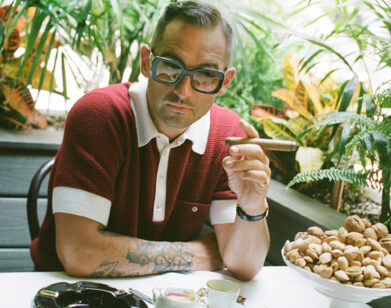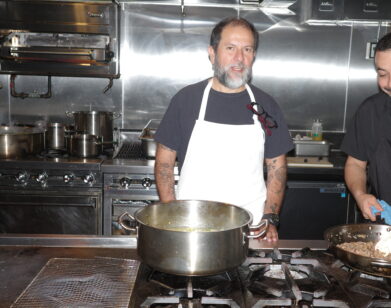Understanding Amy Koppelman
It’s a good time to be writer Amy Koppelman. The end of last month saw the release of I Smile Back, a film based on the New York-based writer’s second novel. In it, comedian Sarah Silverman does a stunning turn as a troubled New Jersey housewife on the edge. On Thursday, Koppelman’s third novel, Hesitation Wounds, will come out via The Overlook Press. Somber and absorbing, Hesitation Wounds follows a renowned psychiatrist Susanna Seliger who is forced to consider her own meticulously papered-over trauma after treating an unraveling patient.
What makes Koppelman’s success all the more gratifying, however, is her unconventional route from bookshelf to cineplex. While Koppelman is familiar with the film industry through her husband, producer and writer Brian Koppelman, her novels are not the page-turning, cliff-hanger types that usually get green-lit by studio execs. Instead, I Smile Back and Hesitation Woulds deal with the gritty, unsettling, and complicated topics of depression and addiction in a prose that is both elegant and quietly devastating. As Koppelman reveals, turning a modest selling novel into a film was as much about chance as it was connections.
JEFFREY VASISHTA: It’s every author’s dream to get a movie made of a novel. How did it happen for I Smile Back?
AMY KOPPELMAN: I was driving up the West Side Highway on the way to get my son up from school. I was listening to Howard Stern, like I always do, and Sarah [Silverman] was on the program talking about her memoir. I can’t remember what she said specifically, but it was something about the tone in her voice. The way she talked about sadness. I just thought, “She’s going to understand what I’m trying to say in ISB.” Maybe a better way to say it is that we all, whether you’re a writer or not, want to be understood. I have been misunderstood more than I’ve been understood in my life and listening to her, I just had the feeling that she would get me. That’s how it all started. I just wanted to get the novel to her. The real miracle is that she bothered reading it. We met at the Trump SoHo and had tea and talked and I asked her if I wrote it, would she consider? She said she would as long as it doesn’t suck! That was a bar I felt I could achieve. I went home and called my screenwriting partner Paige Dylan and we began writing. Brian introduced me to [producer] Mike Harrop and he raised the funds. It took a while because Sarah isn’t known as a dramatic actress, but Mike did it somehow.
VASISHTA: What did Sarah bring to the role that wasn’t perhaps on the page in the novel?
KOPPELMAN: People often ask me and Paige what’s missing from the novel—what we weren’t able to put into the film, etc. What’s amazing about Sarah’s performance is that I can’t even remember what we didn’t get to incorporate into the script because every nuance of Laney’s character emanates from her eyes. What she brought to the role—to the movie—is Laney. She became Laney. I can’t remember who Laney was before Sarah.
VASISHTA: We recently heard about Booker Prize winner, Marlon James, getting his first novel rejected almost 80 times. Do you have a similar story of struggle with I Smile Back?
KOPPELMAN: Oh, I didn’t know. I have to read about that. But yes, to answer your question, ISB was rejected approximately 80 times. Two Dollar Radio [Publishing] was, like, the 81st house to read it. But you only need one “yes.”
VASISHTA: You obviously live in an extremely creative and artistic household with your husband. What type of input do you have on each other’s work and how do you balance it all with being parents?
KOPPELMAN: Well, I’m a mom first. That’s all I really care about—being a good mom and a good wife. The writing always comes second for me. It’s one of the reasons it takes me so long to write a book. Brian gives me great notes because he, perhaps more than anyone else in the world, understands what I am trying to say so he can spot when it’s not working—when I’m not being successful at expressing what I’m trying to express. My kids are older now and give me great notes as well. They both read my writing out loud to me when I ask, so that I can hear it and how it sounds outside of my head. The best part is our kids are actually better writers than us, certainly better than me, and I love that—to read what they write.
VASISHTA: What inspired Hesitation Wounds?
KOPPELMAN: It took me nine years to write and, to be honest, I can’t remember what inspired it. All I know is that I had this brother and sister who really loved each other. One survived their childhood and one didn’t. And I remember being obsessed with graffiti but I don’t remember why. Maybe it will come back to me.
VASISHTA: Depression is lurking beneath the surface with Jim, who can seem quite charming and well adjusted at times and with Daniel, the narrator’s brother, it’s so shocking. How did you go about creating those characters?
KOPPELMAN: I do this thing where I just write and write and write and write for years really until I come upon a scene and then I realize oh—that’s what I’m writing to. That’s my destination. I’m not sure if that makes sense, but it was only when I wrote the final scene in the book did I understand that I was writing a story about Susa finding the strength to forgive herself for surviving and allow herself to love. Fully and completely. Whole.
VASISHTA: It seems that’s one of Susa’s motivations in adopting Mai is to give her life purpose so she doesn’t feel lonely?
KOPPELMAN: I am actually nervous that that will be an interpretation because no—I don’t think it’s about loneliness. I don’t think Susa adopts Mai to feel less lonely. It’s only after Susa has the little girl in her arms that she realizes how lonely she’s been. I guess the better way to say that would be if I had said “shut down” or “guarded” instead of lonely. That’s what I mean: “I didn’t realize how guarded I’d been.” Susa built an entire life, a life that was productive and seemed full, only to shield herself, to isolate herself from the pain of true connection.
VASISHTA: Ray is a thoroughly likable character, a kind of artistic drifter who eventually finds happiness. As a reader there’s always a hope that Ray and Susa would end up together but as a writer, it would have been too obvious. Did you always intend for them to become friends in the end?
KOPPELMAN: Because I do that thing I was just telling you about—the writing and writing and writing for years—I wrote that out: Susa and Ray with a happy ending together. And I loved it. I loved that ending. The two of them adopting Mai. But it didn’t seem real to me. It seemed contrived, like a fairytale. Maybe it’s better to call them true happy endings. They come from within. Ray’s ability to be happy shows Susa that happiness is possible, but it’s only when Susa forgives herself for her brother’s death, and Jim’s death for that matter, that she’s able to be whole again. We know that Ray tried again and again to love Susa enough to heal her. But only Susa could heal herself. And somehow she does. For me, that was the bigger love story. For me, that’s the happy ending.
VASISHTA: New York in the 1970s and early ’80s is currently enjoying a huge wave of nostalgia in books and films, but you didn’t dwell too much on the era, even though that’s when much of it was set. Was that a conscious decision to pull it back?
KOPPELMAN: I have tens and thousands of words, whole chapters that take place in the early ’80s. I know Daniel, Susa and Ray’s childhoods inside and out, but once I wrote to that final scene in the graveyard and understood what the novel was about—who was telling it and why—I realized that I didn’t need most of those scenes so I cut them. But unlike the excess fat in my other novels, I couldn’t let go. So I called my friend Dante Ross who grew up in New York City right around then. I asked him if he’d want to write a TV spec with me about them and he agreed. So Susa, Daniel and Ray’s childhood still lives—in a spec script.
HESITATION WOUNDS WILL COME OUT THIS THURSDAY, NOVEMBER 5, VIA THE OVERLOOK PRESS. I SMILE BACK IS CURRENTLY SCREENING IN SELECT THEATERS.






